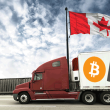by Joseph V. Amato, President and Chief Investment Officer—Equities, Neuberger Berman
When year-over-year inflation hits 7.5%, it’s understandable that attention focuses on the sheer speed of price rises. But it’s the nature of the underlying drivers of that inflation that could make it more persistent, and more challenging—especially for central banks.
Tighter monetary policy cannot get truck drivers and factory workers back on the job, build warehouse space, or make container ships sail faster and ports run more efficiently to clear backlogs. But data being tracked by Michael Barr in our Equity Research team suggest this is how current conditions stand out from previous inflationary episodes.
Bottlenecks
It’s now often said that the current inflation is supply-led rather than demand-led. We think that’s true in important ways, but it also helps to think about it as a perfect storm of demand and supply issues combined.
For example, a lot of the shock to the system appears to be due to the major shift to ecommerce during the pandemic, which is proving sticky. There is simply not enough infrastructure to handle this shift: According to the U.S. Census Bureau, in 2020, U.S. ecommerce sales grew by more than 32%, but warehouse capacity grew by just 2%.
Trucking capacity is also struggling to meet this new demand. SONAR’s Outbound Tender Reject Index, which measures the proportion of loads rejected by carriers, ran up to 25% in 2020. Short-term spikes to these levels are not that unusual, but it is unusual to see similarly elevated rejection rates over a year later.
We see similar bottlenecks further upstream, and similar signs that the impact could be persistent.
At around $15,000 per forty-foot equivalent unit (FEU), average ocean freight spot rates are literally 10 times pre-pandemic levels, according to SONAR. That is despite Alphaliner data suggesting that just 2% of the global container ship fleet is sitting idle. Moreover, forward freight rates suggest that it will still cost more than $8,000 per FEU as far ahead as 2024.
Even if you’re prepared to pay those rates, your goods could still get stuck outside a port: Normally, there’s a queue of 15 – 20 vessels outside U.S. west coast ports; at the beginning of this year, according to Port of Los Angeles reports, there were more than 100. There has been some seasonal easing of the pressure since, but the queue is still unusually long and it’s not clear to us that this will be normalized any time soon.
Overly Rapid Tightening
All of this helps explain why U.S. Producer Price Inflation (PPI) exceeded economists’ forecasts in January, and why the “trimmed mean” measure of Consumer Price Inflation (CPI), which cuts out the biggest price rises and declines, is at highs not seen since records began in 1983. This is not just about energy or used cars—used cars, by the way, went up 37.3% in 2021—it’s about supply and demand being out of whack across the entire economy.
So far, we’ve seen encouraging resilience on the part of businesses and consumers in the face of these pressures.
For instance, FactSet reports that as many as three-quarters of S&P 500 firms have mentioned inflation in their earnings calls for the Q4 season, but on average, net profit margin estimates for 2022 haven’t changed. Companies appear confident in their pricing power—and January’s forecast-beating U.S. retail sales growth suggests that confidence is not misplaced.
But with every passing week in which the data keeps ticking up, we see it raising policy risk for investors. Time and market forces will ultimately ease this current bout of high inflation, but as we note above, some of the current supply-side bottlenecks could cause problems for years, not months. Moreover, as we’ve been writing since last year, we also see structural forces marking an inflection point between the low inflation of the past 20 years and persistently higher inflation over the coming cycles.
If a modest set of rate hikes fails to slow inflation because it has more to do with queues outside ports than over-leveraged consumers, the U.S. Federal Reserve may risk overly rapid tightening in a bid to get some traction. That is not the view of our fixed income team—which anticipates a measured approach from a Fed that is alive to this complex mix of transitory and structural inflationary forces—but it does appear to be the current view from the market, and that could be a source of volatility.
Checkers or Chess?
Even if it gets the balance right for the U.S., the Fed, in essence the world’s central bank, could also find itself setting a policy for the U.S. that is unnecessarily tight for the rest of the world.
Although Europe may be particularly exposed to energy price volatility due to tensions over Ukraine, it’s becoming clear to us that, for various reasons, the U.S. is generally suffering more acute supply bottlenecks than other regions.
For example, European governments generally kept people in their jobs through the pandemic by contributing to the pay of “furloughed” workers, whereas the U.S. chose to support the unemployed. That may be one cause of the imbalance and relative tightness in U.S. labor markets.
And to pick just one part of the goods supply chain, when the World Bank and IHS Markit published their first Container Port Performance Index last year, the most efficient U.S. port was Philadelphia, down in 83rd place. Los Angeles ranked a lowly 328 out of 351. Ports in Asia, the Middle East and North Africa dominated the higher rankings. Algeciras in Spain took Europe’s top spot, ranked 10th overall.
Factors such as these mean that Asia and Europe could use more accommodative policy than the U.S. We believe it would help the European Central Bank avoid setting a policy that might widen peripheral eurozone spreads to uncomfortable levels. It could enable Japan to sustain the economic growth it achieved last year—its first year-over-year expansion since 2018. And it could help China limit this year’s slowdown—the People’s Bank of China is now easing policy, just as the U.S. prepares to tighten.
We believe this is why market participants are so focused on inflation, the underlying drivers of that inflation, and the messaging out of the Fed. Should the central bank end up playing demand-side checkers when the economy is playing supply-side chess, it could cause problems both domestically and worldwide. This is one important reason why we expect continued volatility in markets this year.
Copyright © Neuberger Berman













